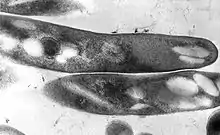Mycobacteriaceae
Mycobacteriaceae is a family of bacteria in the phylum Actinomycetota.[1][2] Its name is derived from the Mycobacterium genus, which includes pathogens known to cause serious diseases in mammals, including tuberculosis (M. tuberculosis) and leprosy (M. leprae) in humans. The Greek prefix myco- means 'fungus', alluding to this genus' mold-like colony surfaces.[3]
| Mycobacteriaceae | |
|---|---|
 | |
| Scientific classification | |
| Domain: | Bacteria |
| Phylum: | Actinomycetota |
| Class: | Actinomycetia |
| Order: | Mycobacteriales |
| Family: | Mycobacteriaceae Chester 1897 (Approved Lists 1980)[1] |
| Genera.[2] | |
| |
Phylogeny
The phylogeny is based on whole-genome analysis.[4][5][lower-alpha 1]
|
fast-growing mycobacteria slow-growing mycobacteria | |||||||||||||||||||||||||||||||
Notes
- Bactoderma and Stibiobacter are not included in this phylogenetic tree.
References
- Chester FD. (1897). "Report of mycologist: Bacteriological work". Delaware Agricultural Experiment Station Bulletin. 9: 38–145.
- Euzéby JP, Parte AC. "Mycobacteriaceae". List of Prokaryotic names with Standing in Nomenclature (LPSN). Retrieved June 16, 2021.
- Mycobacteria: Health Advisory (PDF). Environmental Protection Agency (Report). August 1999.
- Gupta, Radhey S.; Lo, Brian; Son, Jeen (2018-02-13). "Phylogenomics and Comparative Genomic Studies Robustly Support Division of the Genus Mycobacterium into an Emended Genus Mycobacterium and Four Novel Genera". Frontiers in Microbiology. 9: 67. doi:10.3389/fmicb.2018.00067. ISSN 1664-302X. PMC 5819568. PMID 29497402.
- Bachmann NL, Salamzade R, Manson AL, Whittington R, Sintchenko V, Earl AM, Marais BJ. (2020). "Key Transitions in the Evolution of Rapid and Slow Growing Mycobacteria Identified by Comparative Genomics". Front Microbiol. 10: 3019. doi:10.3389/fmicb.2019.03019. PMC 6985099. PMID 32038518.
This article is issued from Wikipedia. The text is licensed under Creative Commons - Attribution - Sharealike. Additional terms may apply for the media files.